Replacing millstones at Felin Ganol 2009-2010
When we arrived at Felin Ganol in 2006 the mill had one pair of 3’6’’ French burr stones and a 4’6” pair of Anglesey stones; the source for the latter is suggested by a fleck of feldspar in the conglomerate. This arrangement had probably been in place since the 1850s when it seems likely that the French burrs were added. The earlier configuration of a single central set of stones may also have been changed to the spur wheel design with two stone nuts at this time. An old grit stone set into the floor of the mill basement has a dress pattern for a clockwise rotation which is what would have been the case before the gearing was introduced. Our current stones have an anti-clockwise rotation.
The Anglesey stones which were probably mainly used for oats and animal feed after the advent of the burr stones were not in a very good state and it was evident that major work would be needed to the hurst frame and to the stones if they were to be of any practical use. The stones had been inverted so the cone shaped runner which had worn very thin was now acting as a bedstone and the milling surface of the other was badly holed. Instead of a conventional hanging or fixed rynd the stones had an interesting gimbal mechanism which I have not seen elsewhere. We would welcome any information on the intended advantages of this design.
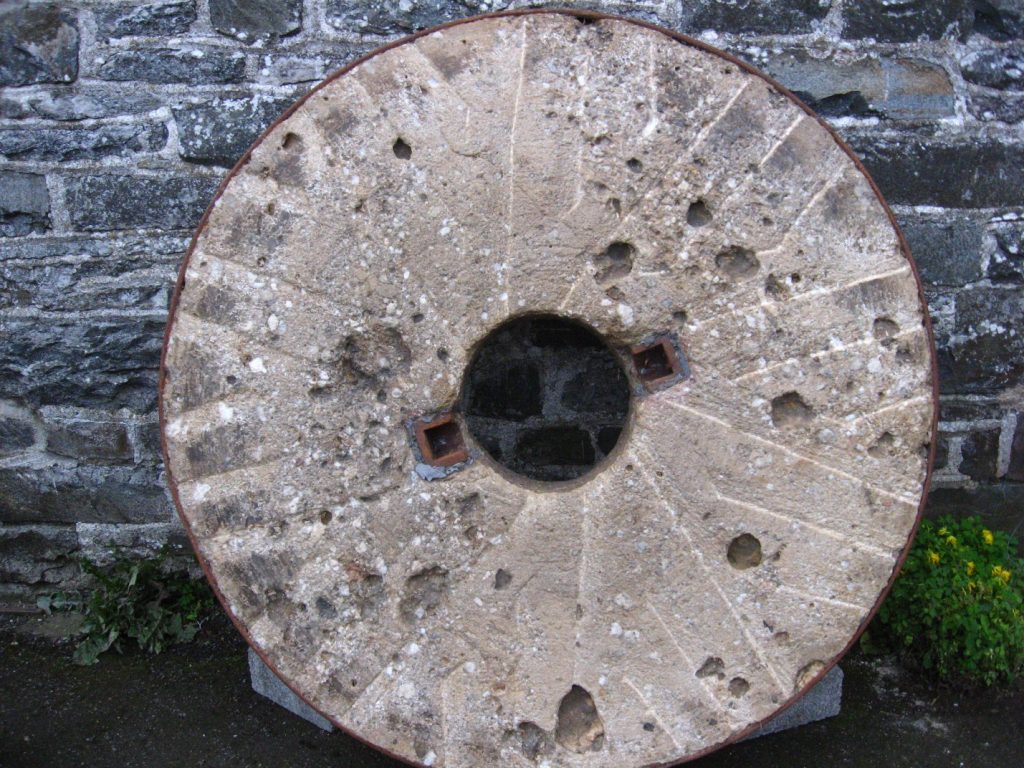
After redressing and balancing, our small French stones were producing very good wheat flour and by 2009 there was a steady local demand for it. However, we felt that another set of burr stones would make for much more resilient and efficient milling allowing us to work on one set of stones whilst milling on the other or using different stones for different grains. Finding a set however, was not quite so easy, despite making pointed comments about unused burr stones during WMS mill visits. Eventually we discovered a set at Felin Dyffryn, Llanilar (1) , a mill which was being converted into a house. The burr stones and grit stones were destined to become garden ornaments but after some persuasion the owner was happy to see the burrs going back to a working mill. The family of the man who built Felin Dyffryn in 1851 still live locally and his granddaughters are still alive; naturally they were also delighted to see the stones being reused. Other items of mill machinery which were purchased at the same time included a stone crane and various cogs and bearing blocks.
The Felin Dyffryn stones had not benefitted from a few years in the open air and the joints between the blocks had lost a good deal of cement in places. Fortunately the iron retaining bands were in reasonable condition. To help prevent disintegration of the stones during transit we applied Plaster of Paris to the worst gaps a few days before they were moved by trailer to Felin Ganol.

The stones were larger (4’6”) than our existing set and also had a very good depth which may point to an easy life, careful milling, or both. They would have had about 90 years of use before the mill ceased working in 1940 but they had only lost an inch or two of their original depth. The mill was finally rendered inoperable when the weir was destroyed by floods in the 1960s. It was interesting to note that the makers plate (Kay & Hilton Liverpool) is identical to that on our existing French burrs. Since we have a date of 1851 for the construction of Felin Dyffryn it is tempting to conjecture that perhaps that was the year that both sets of stones travelled to Aberystwyth or Llanrhystud by boat from Liverpool.
Preparing the stones for dressing and placement in their new home was a rather unglamorous affair involving a lot of cleaning work and refinishing. The mace from the Dyffryn stones was unfortunately missing and since the rynd looked rather insubstantial for the size of the stone it was to support we decided to have new ones manufactured to match the spindle from the removed Anglesey stones. This work was entrusted to LLyr engineering, who used flame-cutting for shaping the two pieces. This was not the traditional method but it was at least possible on a small budget.
Old stone about to leave mill.
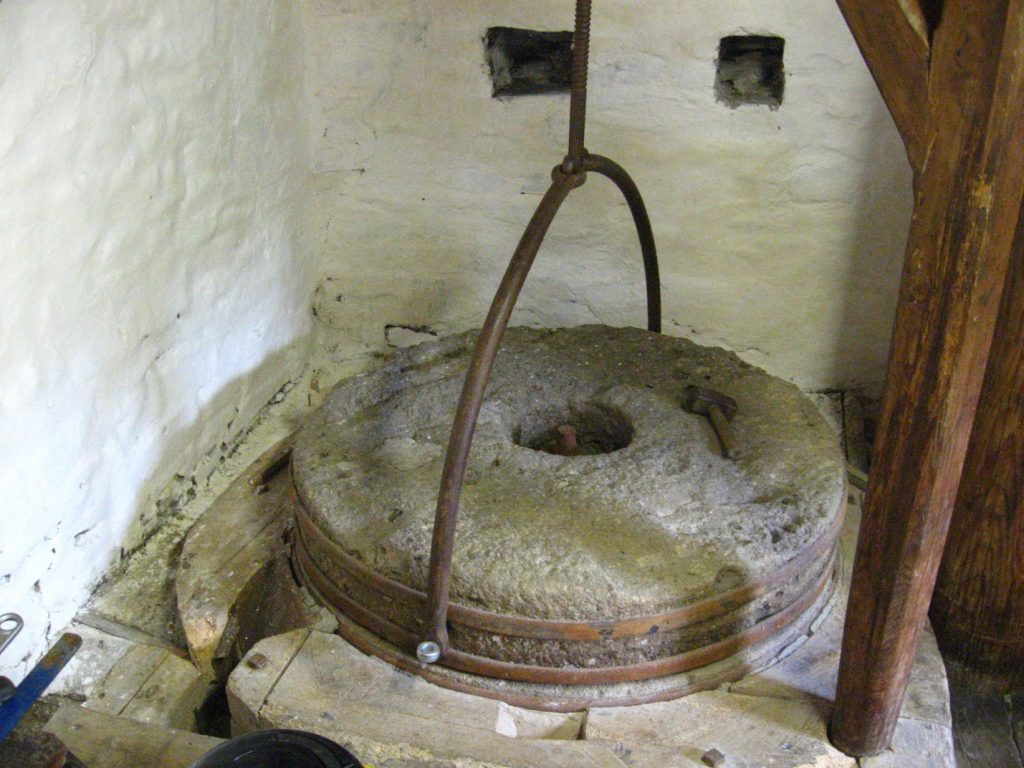
We took advantage of the fact that the stones were away from milling operations in a convenient outbuilding in order to clean them up, re-dress them and fit the new rynd. One of the most awkward tasks was cutting a wider socket in the burr stone for the rynd. An angle grinder cannot cut such recesses very easily so stone chisels were used and the extreme hardness of burr stone was very evident. Once the rynd was inserted it was secured with molten lead and the lead then covered with Plaster of Paris. The old Anglesey stones were then removed after reinforcing the mill floor with planks and Acroprops to prevent them vanishing through it. This was fairly unnerving but not so bad as moving in the new burr stones which were even heavier.
New Burr, restored, dressed and about to take its place in the mill
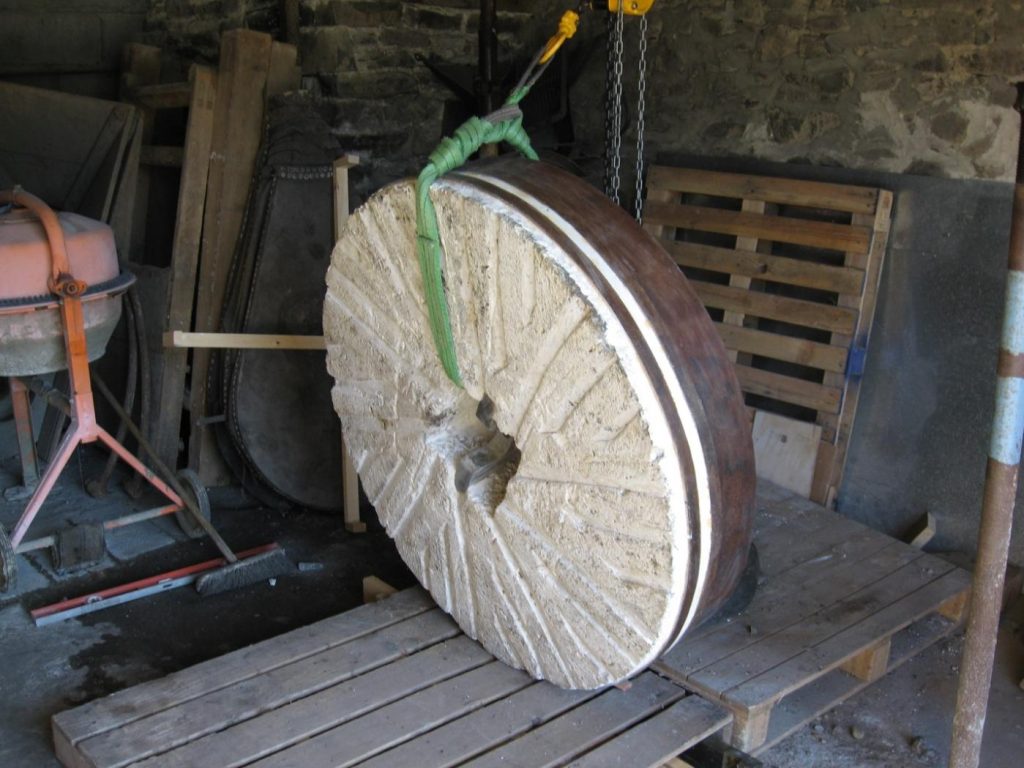
The floor under the millstones was rebuilt using three inch thick pieces of oak. The back wall had to be repaired and lime-pointed and the supporting wall plate replaced, again using oak. The vertical supports around the bridge tree were retained for historical interest, even though they were structurally suspect, as they show evidence of an earlier tentering mechanism. Additional uprights of oak were installed for structural integrity. The bridge tree was very sound and did not need replacing although the insertion point into the back wall was made good while it was removed.
Making sure that the new millstones were at the correct height for the spindle and tentering adjustments was quite critical. The objective was to set the new oak floor at the correct height initially so that subsequent adjustments were kept to a minimum.
The original sealing mechanism on the old stones was rudimentary to say the least. There was evidence of packed sheepswool in the neck bearing, presumably for lanolin lubrication, but there was not much else to prevent a steady stream of flour from falling onto the bridge tree.
Part of gimbal and sealing plate.
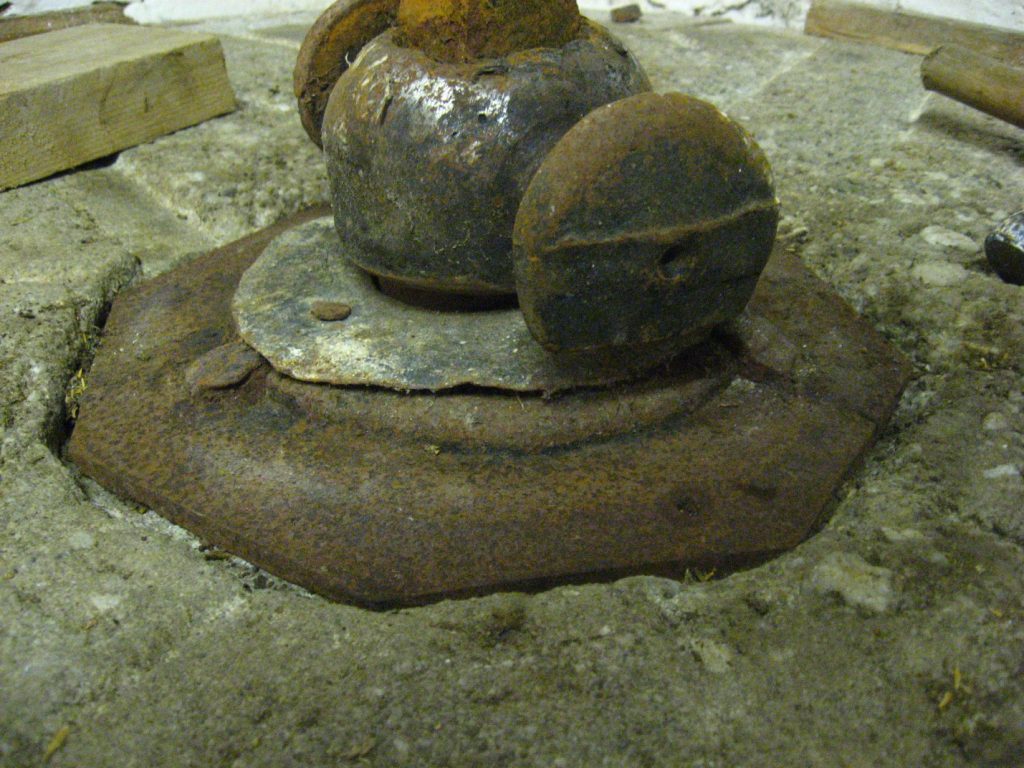
It was interesting to note oats were the only grain evident in the ancient debris around the neck bearing. It also showed that the poor sealing mechanism allowed complete grains through as well as everything else.
On the replacement stones we resorted to the use of modern lip seals to solve this problem. The lip seal is housed in a plywood plate which is set into a recess in the stone surface and sealed with Plaster of Paris. This solution has subsequently been applied to our other set of burr stones.
Refashioned spindle, plywood plate and lip seal which prevents flour from falling through bearing.
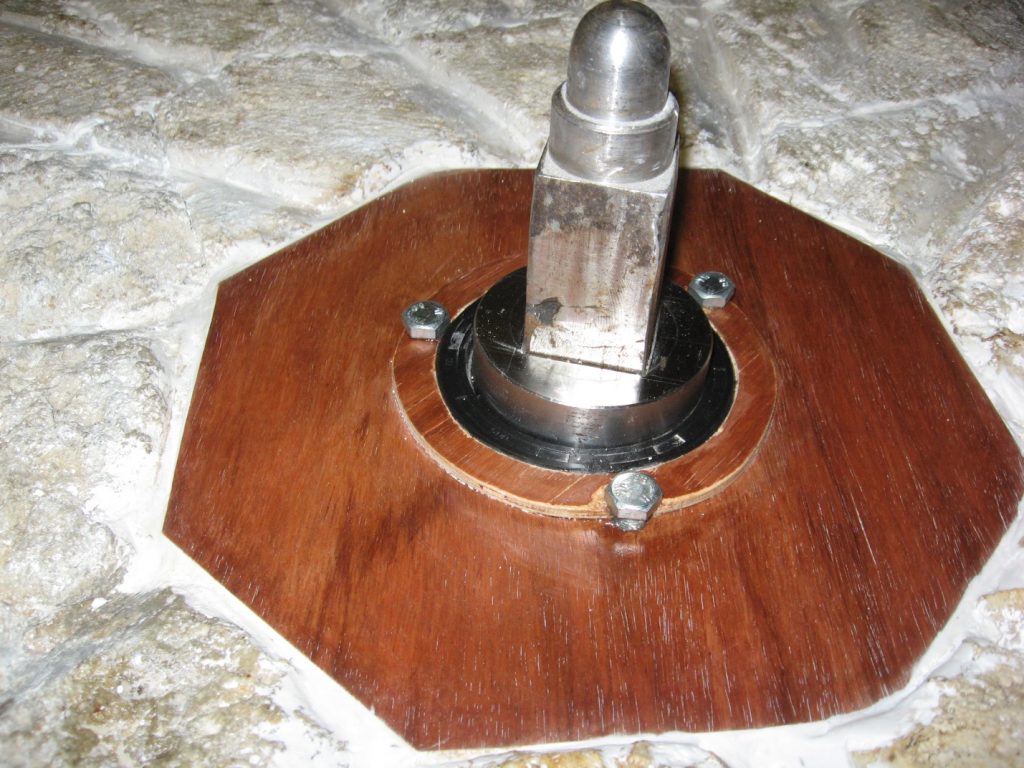
The original shaped pieces of beech which were used to hold the stones in position were good enough to re-use after woodwormed surfaces were removed. These were topped with a flour-proof surround of plywood which was treated with a food-safe oil. Once in position the stones were balanced with lead pieces in the balance pots which were then capped and sealed. The original tun and shoe were retained for display purposes and new ones made in the interests of food hygiene.
In use the new stones seemed very different and almost ‘industrial’ by comparison with the 3’’6’ ones that we were used to. They mill much more rapidly for the same number of revolutions owing to their greater diameter and it was a couple of months before they had fully bedded in and were capable of producing equally fine flour.
Thanks are due to LLyr ap Iolo, Richard Randall and my sons for all their help.
Andrew Parry.
References:
- http://www.coflein.gov.uk/en/site/24704/details/FELIN+DYFFRYN+CORN+MILL%3BFELIN+DYFFRYN+MILL%2C+LLANILAR/